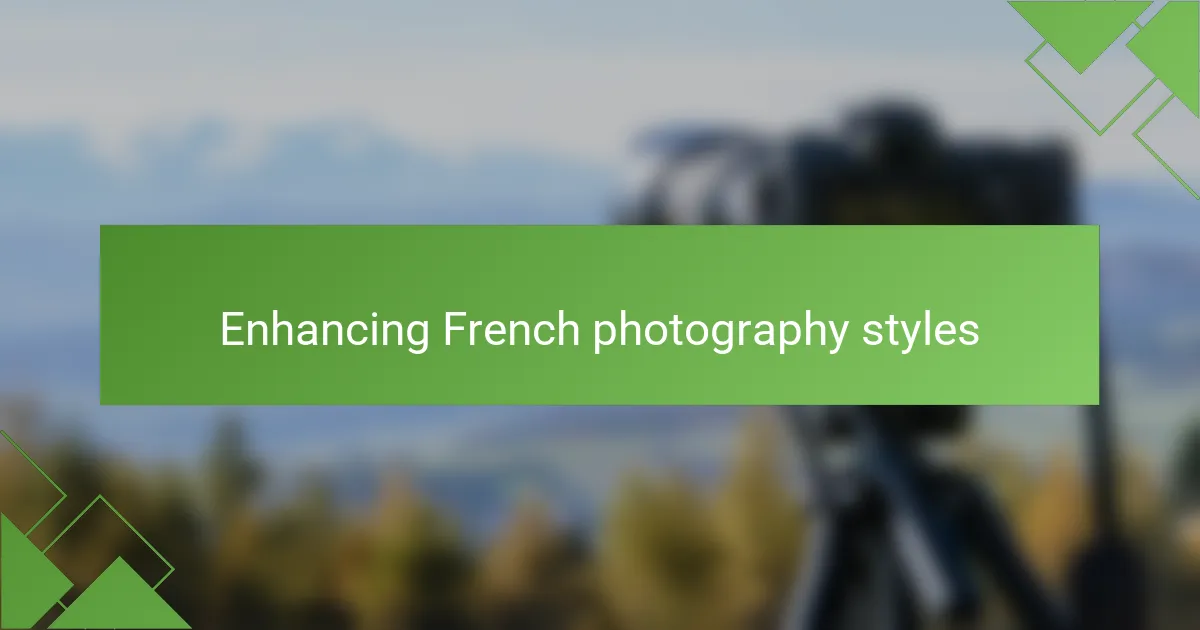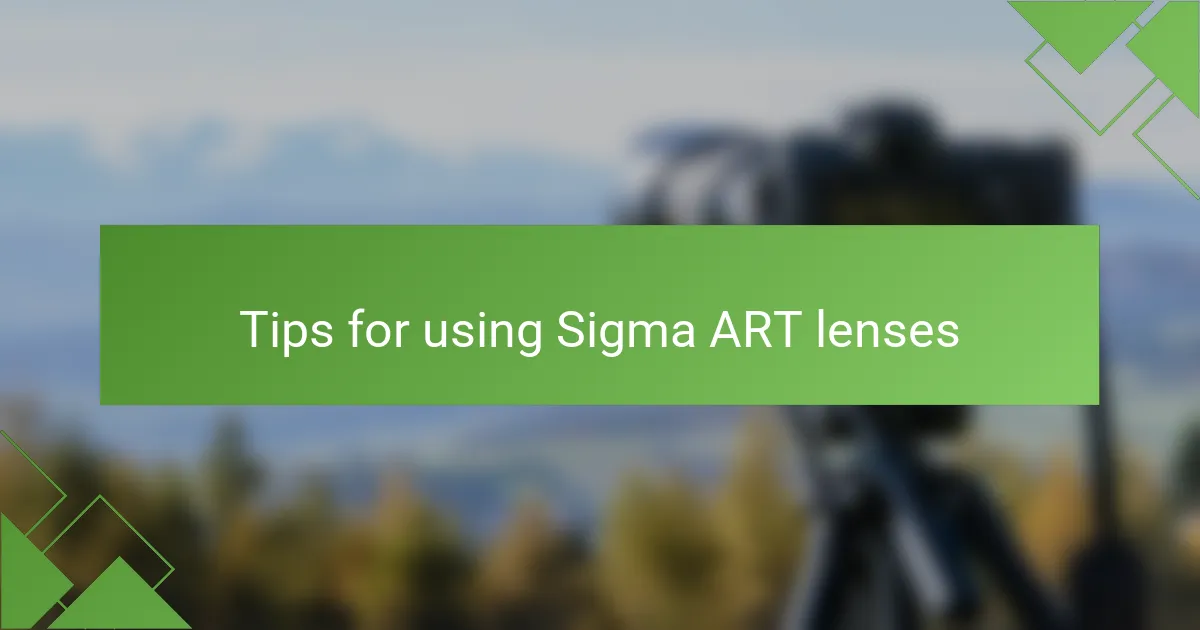Key takeaways
- Sigma ART lenses are renowned for their sharpness and exceptional optical performance, making them suitable for both professionals and amateurs.
- The versatility of these lenses allows for various photography styles, from portrait to landscape, while ensuring consistent color reproduction.
- Quality gear, like Sigma ART lenses, elevates photography portfolios by providing stunning clarity, depth, and a cohesive aesthetic.
- Practical tips for using Sigma ART lenses include experimenting with apertures for bokeh effects and ensuring proper calibration for optimal performance.

Overview of Sigma ART lenses
When I think about Sigma ART lenses, I’m really struck by their incredible optical performance. These lenses are crafted with precision, which translates to stunning image quality that meets the needs of both professional and amateur photographers alike. Have you ever captured an image that felt too vibrant to be true? That’s the magic of the Sigma ART lineup.
What I particularly appreciate is the versatility of these lenses. From wide-angle to telephoto, Sigma offers a range that can adapt to various shooting styles and scenarios. I remember using the 35mm f/1.4 ART lens for a portrait session—it beautifully rendered skin tones while providing a dreamy background blur, or bokeh, that adds a touch of artistry to my photos.
The build quality is another aspect that really resonates with me. Sigma ART lenses feel solid and substantial in hand, which gives you confidence as you shoot. Have you noticed how good gear can enhance your creative process? For me, these lenses inspire a level of creativity that simply elevates my photography experience.

Benefits of Sigma ART lenses
The sharpness of Sigma ART lenses is truly remarkable. I’ve often found myself captivated by how details spring to life—every hair, every texture. Have you ever looked at your photos and felt that rush of satisfaction from seeing clarity like never before? It’s a game-changer, especially in genres like portrait and landscape photography.
Another benefit lies in their exceptional low-light performance. I recall a night shoot where the ambient light was minimal. With the Sigma 24mm f/1.4, I was able to maintain those vibrant colors without compromising on clarity. It’s comforting to know that no matter the lighting conditions, these lenses can perform and deliver stunning results.
The price-to-performance ratio of Sigma ART lenses is something I genuinely appreciate. When I compare them to other high-end brands, it feels like I’m getting the best of both worlds. Has investing less in equipment ever made you feel freer to experiment? With these lenses, I feel empowered to push boundaries and explore new creative directions without breaking the bank.

Importance in photography portfolios
When it comes to photography portfolios, the quality of your images can make or break the first impression. I’ve seen portfolios that rely on mediocre lenses, and let me tell you, they just don’t have the same impact. Can a portfolio truly shine without sharp, vibrant images? I believe that investing in high-quality Sigma ART lenses elevates your work and reflects your dedication to the craft.
Having a cohesive aesthetic in your portfolio is essential, and Sigma ART lenses help achieve that. I remember curating a selection for a recent project; the consistent color reproduction across different focal lengths made editing a breeze and ensured a harmonious look. Do you ever find yourself struggling to maintain consistency in your work? With the right tools, it’s a lot easier to achieve that unified vision.
Lastly, showcasing your best work is all about presenting images that resonate with viewers. When I look back at my own portfolio, the images taken with Sigma ART lenses tend to stand out in terms of depth and clarity. Don’t you think it’s essential to offer potential clients or collaborators a look at your absolute best? I truly believe these lenses contribute significantly to that professional polish that can set you apart in a competitive field.

Enhancing French photography styles
When it comes to enhancing French photography styles, Sigma ART lenses are truly remarkable tools. I’ve found that these lenses can capture the essence of French landscapes and architecture with stunning clarity and precision. Whether shooting in a quaint café or a bustling Parisian street, the vibrant colors and sharp details they deliver often leave me in awe.
I remember the first time I used a Sigma ART lens during a photoshoot in Montmartre. The way it rendered the cobblestones and the soft light at sunset created an almost painterly quality. It made me appreciate the nuances of natural light and shadow more than ever. For anyone aiming to capture the romantic allure of France through photography, I firmly believe these lenses can elevate your work.
Here’s a quick comparison of some key Sigma ART lenses and their benefits specifically for French photography styles:
| Lens Model | Key Features |
|---|---|
| Sigma 35mm f/1.4 | Exceptional low-light performance, ideal for street photography |
| Sigma 50mm f/1.4 | Great for portraits and capturing detail in architecture |
| Sigma 24-70mm f/2.8 | Versatile zoom range perfect for landscapes and cityscapes |

Personal experience with Sigma ART lenses
Using Sigma ART lenses has genuinely transformed my photography experience. I vividly recall my first outing with the 50mm f/1.4 during a captivating twilight shoot in a French courtyard. The way the lens captured the soft glow of the lanterns against the night sky was enchanting. Have you ever had a moment where your camera just clicked and everything felt perfect? That’s how I felt—like I was finally able to translate what I saw into something tangible.
Another memorable experience was shooting with the Sigma 24-70mm f/2.8 at a local festival. The versatility of this lens was impressive. One moment I was capturing wide shots of vibrant decorations, and the next, I was zooming in to capture joyful expressions on people’s faces. It made me realize how essential it is to have a lens that adapts seamlessly to different situations. Has a lens ever made you feel more connected to your surroundings? With the Sigma ART series, I felt that connection deepened.
I still think about a portrait session I had with a musician in a dimly lit café using the 35mm f/1.4. The depth of field produced that perfectly blurred background, bringing the subject into striking focus. Each frame felt like a story waiting to be told. In those moments, I understood why investing in quality equipment was crucial. Don’t you think it makes a difference when you can trust your gear? Sigma ART lenses have given me that confidence and so much more in my photography journey.

Tips for using Sigma ART lenses
When using Sigma ART lenses, one key tip is to take advantage of their remarkable sharpness. I’ve used the 35mm f/1.4 ART lens for portrait photography, and the details were stunning, even in challenging lighting conditions. Don’t hesitate to experiment with different apertures; the bokeh produced at wider settings is truly beautiful and can add a unique touch to your images.
Additionally, always ensure your lens is properly calibrated with your camera. I once encountered inconsistent focus issues until I used Sigma’s USB Dock to adjust the settings. This small step made a significant difference, enhancing my overall shooting experience and results. Finally, remember that these lenses are somewhat heavier compared to standard ones, so a sturdy tripod is your best friend when planning for longer shoots.
| Aspect | Sigma ART Lenses |
|---|---|
| Sharpness | Exceptional clarity and detail across the frame |
| Bokeh | Beautiful, smooth background blur at wider apertures |
| Calibration | Requires calibration for best performance; USB Dock recommended |
| Weight | Heavier than standard lenses; consider a tripod |